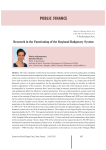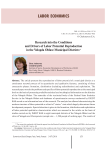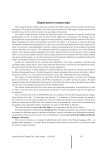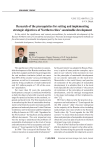Economic and Social Changes: Facts, Trends, Forecast @volnc-esc-en
Статьи журнала - Economic and Social Changes: Facts, Trends, Forecast
Все статьи: 1728

Research and innovation activity in the region as a driver of its sustainable economic development
Статья научная
In the unstable economic environment there is an ongoing search for ways to strengthen economic stability in the regions. The development of research and innovation activities can be considered a long-term fundamental factor in solving this problem. The aim of the study is to identify the following trends in the production and distribution of innovation in the macro-region: creation and development of a polycentric structure of research and innovation activities in the regions and possible forms of its strengthening from the standpoint of economic stability in the regions. As the method of research we use structural and functional analysis of the research and innovation space of the macro-region, its current status and development trend. In the course of our research we substantiate the tendency toward the formation of a polycentric structure of scientific and innovation activity. We provide the data characterizing it in the macro-region of the North-West of Russia: location of scientific organizations in the region, their employees, internal costs allocated to research and development, amount of higher education institutions and branches of higher education institutions established in the regions, which train highly qualified personnel for various sectors, including region’s own scientific base, and serve as a source of local innovation...
Бесплатно

Research in the functioning of the regional budgetary system
Статья научная
The state regulation conducted in accordance with the current economic policy plays a leading role in the formation and development of the economic structure of modern society. The financial system carries out control activities in the market economy through financial mechanisms by means of financial levers and incentives to achieve financial objectives. Regional public finance, as a major part of the RF financial system, is of great importance for the reproductive process during the transfer to effective market organization of the economy. The state budget is the main link of the financial system. It is an incomparable by its amount monetary fund, winch has huge investment potential and can quantitatively and qualitatively affect the efficiency of social production. The use of this potential to a great extent will determine a development direction and regional economy sustainability. The stability of the budget system is seen in the concept of long term socio-economic development of Russia until 2020 as a vital condition for the solution of strategic economic and social objectives of financial provision of innovative development of the economy...
Бесплатно

Статья научная
The article presents the reproduction of labor potential of a municipal district as a continuous renewal process of its quantitative and qualitative features, consisting of three consecutive phases: formation, distribution (including redistribution) and exploitation. The research paper reveals the problems and specifics of labor potential reproduction at the municipal level on the basis of processing available statistical and sociological information on the districts of the Vologda Oblast. The materials of the territorial body of the Federal State Statistics Service in the Vologda Oblast and databases of questionnaire surveys conducted by ISEDT RAS served as an information base of the research. The analysis has allowed characterizing the modern structure of labor potential as a kind of “starter” state which largely determines future development prospects. Special attention is given to the formation, distribution and exploitation of labor potential qualitative characteristics which are assessed in the article on the basis of studies carried out by ISEDT RAS in eight municipal districts of the Vologda Oblast and the cities of Vologda and Cherepovets (sample size - 1,500 people of working age)...
Бесплатно


















